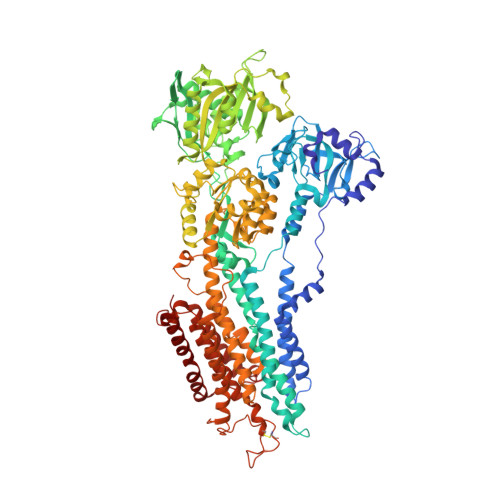Trinitrophenyl derivatives bind differently from parent adenine nucleotides to Ca2+-ATPase in the absence of Ca2+.
Toyoshima, C., Yonekura, S., Tsueda, J., Iwasawa, S.(2011) Proc Natl Acad Sci U S A 108: 1833-1838
- PubMed: 21239683
- DOI: https://doi.org/10.1073/pnas.1017659108
- Primary Citation of Related Structures:
3AR2, 3AR3, 3AR4, 3AR5, 3AR6, 3AR7, 3AR8, 3AR9 - PubMed Abstract:
Trinitrophenyl derivatives of adenine nucleotides are widely used for probing ATP-binding sites. Here we describe crystal structures of Ca(2+)-ATPase, a representative P-type ATPase, in the absence of Ca(2+) with bound ATP, trinitrophenyl-ATP, -ADP, and -AMP at better than 2.4-Å resolution, stabilized with thapsigargin, a potent inhibitor. These crystal structures show that the binding mode of the trinitrophenyl derivatives is distinctly different from the parent adenine nucleotides. The adenine binding pocket in the nucleotide binding domain of Ca(2+)-ATPase is now occupied by the trinitrophenyl group, and the side chains of two arginines sandwich the adenine ring, accounting for the much higher affinities of the trinitrophenyl derivatives. Trinitrophenyl nucleotides exhibit a pronounced fluorescence in the E2P ground state but not in the other E2 states. Crystal structures of the E2P and E2 ∼ P analogues of Ca(2+)-ATPase with bound trinitrophenyl-AMP show that different arrangements of the three cytoplasmic domains alter the orientation and water accessibility of the trinitrophenyl group, explaining the origin of "superfluorescence." Thus, the crystal structures demonstrate that ATP and its derivatives are highly adaptable to a wide range of site topologies stabilized by a variety of interactions.
Organizational Affiliation:
Institute of Molecular and Cellular Biosciences, University of Tokyo, Tokyo 113-0032, Japan. [email protected]



















